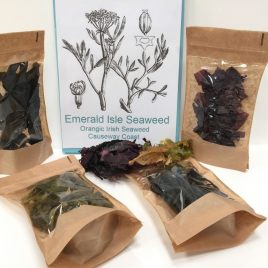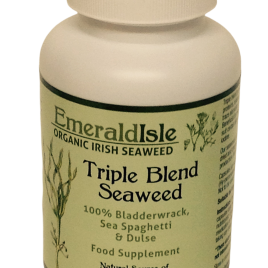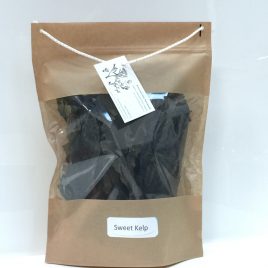Description
Kelp Kombu (laminaria Digitata) 40 grams
Kelp Kombu seaweed will have the most iodine compared to the other seaweed vegetables, its flavour is known as the fifth taste (umami).
Cooking:
Can be cooked as a sea vegetable or used for baking, It is used in Japan and China for making dashi, a soup stock.
kelp Kombu is best boiled in soups.
A great way to add seaweed in practically anything savoury you eat.
Use only 1/2 table spoon pps.
The size of the Kombu granules in this sachet are 1mm/powder, we also sell Kombu 2-4 mm flakes in a sachet.
Certified Organic by the Irish Organic Farmers and Growers Association.
“Like all sea vegetables, kelp provides minerals found in sea water, especially iodine and trace minerals that may be leaking in our depleted soils.
For Westerners unaccustomed to including seaweed in the diet, a small daily supplement of kelp, in tablet or powdered form is a good idea, but don’t overdo -excess iodine may also cause thyroid problems.” Sally Fallon and Mary G Enig PhD ; Nourishing Traditions Cookbook.
L. digitata is a tough, leathery, dark brown seaweed that grows to two or three metres. The holdfast which anchors it to the rock is conical and has a number of spreading root-like protrusions called rhizoids. The stipe or stalk is flexible and oval in cross section. The blade is large and shaped like the palm of a hand with a number of more or less regular finger-like segments.
This seaweed can be distinguished from the rather similar Laminaria hyperborea by being darker in colour and having a shorter stipe that does not easily snap when bent.
Customers can be fully assured with the quality of our products. Our seaweed has undergone a full range of thorough tests which include chemical, pesticides, water content, and nutrition. All of which have been carried out in laboratory conditions.
All tests carried out are UKAS accredited. The HACCP control system is also in place.





